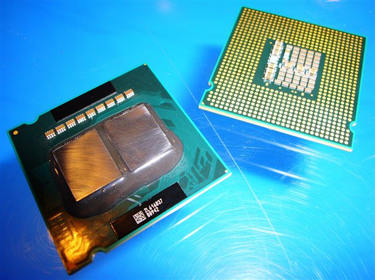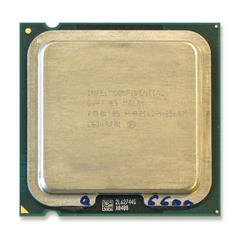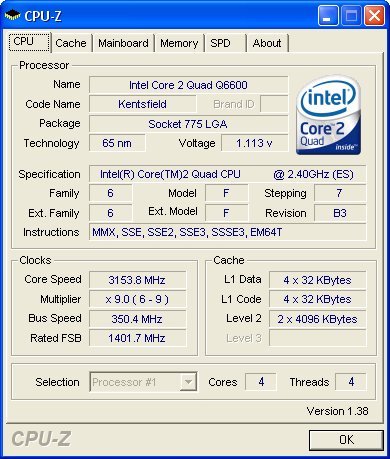INTEL CORE 2 QUAD Q6600 REVIEW BENCHMARK AND OVERCLOCK
![]()
|
|
 |
||||||||||||||||||||||||||||||
| Posted:2007-01-08 By cpu review Number of View:136317 |
|||||||||||||||||||||||||||||||
By :cpu review Posted:2007-01-08
Two months after the launching of its first processor quad-core, Core 2 Extreme QX6700 tested in our review section in beginning of November , INTEL are back with a second processor quad-core. This time, it does not act more like one Extreme model Core 2 Quad. Concretely, the new one come to be more accessible than its predecessor, the goal of the founder being to democratize his technology quad-core as soon as possible, whereas its competitor, AMD, still do not have similar solution. Halfway between Core 2 Duo and Core 2 Extreme, Core 2 Quad Q6600 is today the only representative of family, Core 2 Quad, which is dedicated to increase throughout 2007. Technically identical to Core 2 Extreme QX6700, Core 2 Quad Q6600 should however suffer from the same problem as his big brother, the software environment not being optimized yet for this type of processors massively parallel. The occasion for us to see whether the things moved in less than two months while checking the performances of the small last intel cpu :-) .
INTEL Core 2 Quad: we takes the same ones and one starts again! Technically, Core 2 Quad takes again architecture of Core 2 Extreme QX6700 and known under name Kentsfield code. Concretely, INTEL uses receipt that it had already applied in the past with Pentium D. Rather than to join together four core to only one INTEL sticks literally two Core 2 Duo on the same physical chip. The characteristic of Core 2 Duo being to be processors dual core. Technically, Core 2 Quad takes again architecture of Core 2 Extreme QX6700 and known under name Kentsfield code. Concretely, INTEL uses receipt that it had already applied in the past with Pentium D. Rather than to join together four core to only one INTEL sticks literally two Core 2 Duo on the same physical chip. The characteristic of Core 2 Duo being to be processors dual core.Undoubtedly, the solution adopted by INTEL misses elegance and we will criticize the fact that the bus system is always limited to 1066 MHz in quad-pumped (4x266 MHz thus). The theoretical band-width between the chipset and memory thus does not move and stick to 8,5 GIG/S. While waiting, To bus 1066 MHz has an interest all the same since the current motherboard containing chipsets INTEL i975X or P965 are in fact compatible with this first Core 2 Quad. The other reproach which we will address to the design of Kentsfield relates to the fact that both core are partitioned: any communication between them must pass by the bus system and thus the chipset what can generate considerable time wastand load. Finally the cache is divided between the four core witch surely a benefit from Core 2 Quad  Of course the current implementation of Kentsfield has its advantages , but those are primarily related to the manufacturing process. First advantage for INTEL, the founder has more outlets for its core Core 2 Duo at factory: same core will be able to be placed on Core 2 Duo, Core 2 Quad or Core 2 Extreme. Second favors is that the production of small core size gets better output compared to the production of only one die quad-core whose size would be necessarily more imposing. INTEL Core 2 Quad Q6600: the processor, consumptionPhysically, the last small INTEL cpu has the format Socket LGA775 and it preserves its heatspreader with metal protection. With nearly 585 million transistors, it remains built in 65 Nm. Just like first Core 2 Extreme envoys in the last November, Core 2 Quad Q6600 uses the B3 revision Kentsfield core, a stepping which consumes and heats less than traditional B2 Core 2 Duo. Its supply voltage relatively weak since is raised with 1,176 volts on our test. According to INTEL documents it can vary between 0,9v and 1,5v to the maximum. by a FSB of 1066 MHz, the processor is working at 2,4 GHz and uses a multipler of 9x. Small difference with Core 2 Extreme QX6700, the coefficient is blocked here upwards: impossible thus to increase it.
Having 8 Mb memory in the second level (4 Mb per die), Core 2 Quad Q6600 takes again the usual functionalities of Core 2 Duo. we thus finds famous INTEL with Enhanced INTEL Speedstep for the frequency modulation and voltage according to the use of the system or the assumption of VT, the techology of virtualisation . The EM64T is of course one part, you will be able to use Core 2 Quad with the version 64 bits of Windows Vista, just like instructions SSSE3 (Supplemental SSE3) intended to make us have patience before the arrival of instructions SSE4. the processor also supports Sayable Bit which makes possible to prohibit with the programs the access in writing to certain beaches memories and this in order to reduce the harmful effects generated by viruses. Lastly, Core 2 Quad Q6600 is certified INTEL Viiv.
3DMark 06 - CPU - v1.1
PCMark 05 - CPU Test - v1.2.0
PCMark 05 -Memory Test - v1.2.0The memory test of PCMark 05 hardly seems to benefit from the quad-core. Our Core 2 Quad Q6600 is almost with equality with Core 2 Duo E6600 which operates let us recall it at the same frequency whereas Core 2 Extreme QX6700 is a not in withdrawal vs Core 2 Duo E6700. The large winner is Core 2 X6800 Extreme which has here the first position. Sandra Xi - Processor Test
This test of million operations in floating point at second or million instructions in second, the processors quad core excuted sucsesfully the test . Here Core 2 Quad and other Core 2 Extreme QX6700 post scores practically twice higher than their counterparts Core 2 Duo. Processors AMD are thus for their part in complete lost !!!. Sandra Xi - Memory Test
ScienceMark 2.0 PrimordiaScienceMark 2.0 simulates various mathematical calculations to estimate the performances of a given system. The contribution of the four core is completely null here, our two processors quad core show identical performances, we see them in withdrawal, vs Core 2 Duo at the same frequency. For sure here Core 2 X6800 Extreme is at the head with performances 6% higher than those of Athlon 64 FX62 which finishes here in second position. , CineBench 9.5CineBench is based on the engine 3D of professional application Cinema4D and measurement of time put by each one of our systems to excute the scene. Multi-threaded, software will really favors the four core processors since Core 2 Quad Q6600 show 66% faster performance here than its equivalent provided with only two core and working at the same frequency . Vs Core 2 Extreme X6800, Core 2 Quad Q6600 showing 36% faster result. As for Core 2 Extreme QX6700, it remain 14% swifter than Core 2 Quad Q6600. Adobe Photoshop CS2We benefit from the new year to adopt version 2.0 Photoshop CS. The occasion to change our test to use in this time the filter of radial blur, a multi-threaded filter. We measure time necessary to the application of this filter on an image of 2.048 X 3.072 resolution. Attention, the results are expressed in second. The processors quad core are at the head. Whereas we needs nearly one minute for our Core 2 Duo E6600 to apply the filter, the same operation is done in thirty seconds on Core 2 Quad Q6600! If Core 2 Extreme QX6700 is faster than Core 2 Quad Q6600, the difference between the two processors is really tiny: hardly two seconds. Windows Media Encoder 9.0
Files Compression - WinRAR 3.62
3DSMax 8 - RadiosityWith 3DSMax 8, we measure time necessary to complete the scene 3D in 800x600 with effects of radiosity. The results are once again expressed in seconds and the processors quad-core seem here to give their full potential. The small new one cpu, Core 2 Quad Q6600 excuted the scene in 37 seconds less than Core 2 Duo E6600. Processors AMD thus close again here the ball and Core 2 Quad Q6600 spends 35 seconds less than Athlon 64 FX62 to excute it. TMPGenc 4.0TMPGenc is a software of encoding which we used here to convert a AVI of almost 1 Gig to format MPEG2 with bit rate of 9000 Mb/S. TMPGenc has an interesting future that it uses the pre-SSE4 instructions of processors Core 2 Duo. The results are expressed in seconds. The quad-core from INTEL are shown definitely more powerful than their counterparts Core 2 Duo having very significant profits. Whereas it takes 226 seconds for Athlon 64 FX62 for video encoder the same film will be converted into MPEG2 in only 140 seconds with Core 2 Quad Q6600. The difference between Core 2 Quad Q6600 and Core 2 Extreme QX6700 is tiny here. If one compares Q6600 with his counterpart dual-core E6600, the model quad-core spends 54 seconds less . Studio 10.7Under Studio 10 we excuted a complete video project. as a start the compression with format MPEG 4 with a bit rate of 6 Mb/S. the results here are still expressed in seconds. Processors AMD remain slowest and quad-core INTEL does not bring here any profit in performances vs processors with dual-core. Core 2 X6800 Extreme is fastest to excute our project. Vs Core 2 Quad Q6600, Core 2 X6800 Extreme saves 33 seconds. Mathematica 5.1
Call Off Duty 2 - v1.3 - 1024x768x32
Doom 3 v1.3 - 1024x768x32To more than 200 fps, Doom 3 is severely limited by the graphics card. Result, all our processors are in a same fps range and only Athlon 64 X2 5000+ show lower performance. Far Cry - v1.4 - 1024x768x32
OverclockingCore 2 Quad Q6600 not making party of the great family Core 2 Extreme, its coefficient multiplyer is blocked (only upwards). Impossible thus for overclocker to easily overclock Q6600 as its big brother QX6700. For our part, we did not exceed the 3,15 GHz frequency with a multiplyer of 9x and FSB with 350 MHz. . To reach a frequency of 3,15 GHz, it was necessary for us to increase the vcore and to reduce our memory latency . Finally this overclocking was done on the P5W-DH Deluxe from Asus with the boxed origin INTEL cooler.
ConclusionFor INTEL, the future is with the multiplication of the core number and the arrival of Core 2 Quad is well to popularize the four core processors . Naturally the software environment is not ready today to profits from four core as it is in same time limited to dual core cpu . In majority the cases, Core 2 Quad Q6600 makes equal performance with Core 2 Duo E6600. But with the real multithreaded software, like video applications or 3d rendering software the profits offered by this new processor are sometimes spectacular. Creation by INTEL of a new family of processors located halfway between Core 2 Duo and Core 2 Extreme, is a chance to make pressure on the developers of software to start to use of greatest number of core placed at their disposal by the last processors in date.
we would be happy to answer for your question . if you have suggestion or comment
regarding this review our support would be glad to help just join our forum and ask u will get the best answer
to discuss check our forum section :-) RATE THIS REVIEW | |||||||||||||||||||||||||||||||
![]()

Intel Core 2 Quad Q6600 review benchmark and overclock
Intel Core 2 Quad Q6600 review benchmark and overclock


7600gt review
7600gt is the middle card range.
We already benchmarked this video card and found that ...

 geforce 8800gtx and 8800gts
geforce 8800gtx and 8800gts  Xtreview software download Section
Xtreview software download Section  AMD TURION 64 X2 REVIEW
AMD TURION 64 X2 REVIEW  INTEL PENTIUM D 920 , INTEL PENTIUM D 930
INTEL PENTIUM D 920 , INTEL PENTIUM D 930  6800XT REVIEW
6800XT REVIEW  computer hardware REVIEW
computer hardware REVIEW  INTEL CONROE CORE DUO 2 REVIEW VS AMD AM2
INTEL CONROE CORE DUO 2 REVIEW VS AMD AM2  INTEL PENTIUM D 805 INTEL D805
INTEL PENTIUM D 805 INTEL D805  Free desktop wallpaper
Free desktop wallpaper  online fighting game
online fighting game  Xtreview price comparison center
Xtreview price comparison center 

- The new version of GPU-Z finally kills the belief in the miracle of Vega transformation
- The motherboard manufacturer confirms the characteristics of the processors Coffee Lake
- We are looking for copper coolers on NVIDIA Volta computing accelerators
- Unofficially about Intels plans to release 300-series chipset
- The Japanese representation of AMD offered monetary compensation to the first buyers of Ryzen Threadripper
- This year will not be released more than 45 million motherboards
- TSMC denies the presentation of charges from the antimonopoly authorities
- Radeon RX Vega 64 at frequencies 1802-1000 MHz updated the record GPUPI 1B
- AMD itself would like to believe that mobile processors Ryzen have already been released
- AMD Vega 20 will find application in accelerating computations
- Pre-orders for new iPhone start next week
- Radeon RX Vega 57, 58 and 59: the wonders of transformation
- ASML starts commercial delivery of EUV-scanners
- The older Skylake processors with a free multiplier are removed from production
- Meizu will release Android-smartphone based on Helio P40
- AMD Bristol Ridge processors are also available in American retail
- The fate of Toshiba Memory can be solved to the next environment
- duo GeForce GTX 1080 Ti in GPUPI 1B at frequencies of 2480-10320 MHz
- New Kentsfield overclocking record up to 5204 MHz
- Lenovo released Android-smartphone K8



computer news computer parts review Old Forum Downloads New Forum Login Join Articles terms Hardware blog Sitemap Get Freebies






 To test the performances of this INTEL cpu we had recourse to the following platform i975X:
To test the performances of this INTEL cpu we had recourse to the following platform i975X:
